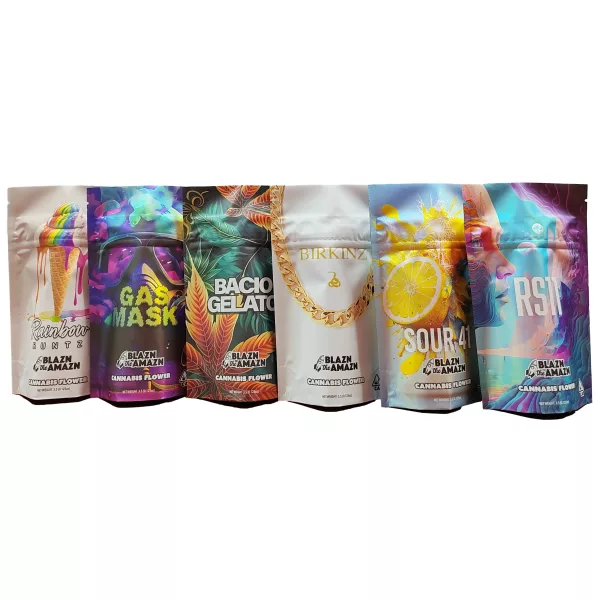
Top Safety Priority
Medicines, vitamins, cleaning products—child resistant packages keep them out of curious children’s hands. Child proof packaging and child resistant pouches combine protection with convenience, protecting children while making it simple for adults. For pharmaceutical, cannabis, and household markets, this kind of packaging is a complete barrier, satisfying strict controls and ease of use.
How Child-Proof Packaging Works
Child-proof packaging incorporates mechanisms that rely on dexterity, strength, or cognitive functioning beyond a young child’s abilities. Common designs are:
- Push-and-Turn Caps: Used on pill containers, which must be pressed downward while twisted in order to open.
- Squeeze-and-Slide Pouches: Child-resistant pouches use zippers which need to be squeezed and pulled simultaneously, unmanageable with little fingers.
- Dual-Action Closures: Packages need two actions, for example, alignment of tabs or the pressing of more than a single point, to open.
- Opaque Materials: Non-transparent packaging conceals contents, diminishing a child’s curiosity.
These attributes comply with standards such as the U.S. Consumer Product Safety Commission’s (CPSC) standards, which check whether children under five can open the package within a specified time. For instance, a cannabis pouch may employ a double-zipper mechanism, proving compliance while making it possible for an adult to open it within seconds. The intention is obvious: keep kids out, not convenience.
Why It’s Essential
Child-resistant packaging is more than a regulatory check box—it’s a life saver. Thousands of children are hospitalized annually as a result of accidental poisoning, typically from ingesting chemicals or medicine. This packaging minimizes those risks by inserting a valuable buffer.
Beyond safety, it delivers useful benefits:
- Regulatory Compliance: Pharms and cannabis businesses must meet stringent laws, such as the Poison Prevention Packaging Act, or face fines or recall.
- Consumer Confidence: Caregivers and parents favor safer packaging products, enhancing brand loyalty.
- Product Integrity: The majority of child-proof pouches utilize tough, tight materials to protect contents from moisture or air, enhancing shelf life.
- Market Advantage: Compliant, appealing designs stand out in competitive markets like household or wellness products.
A pharmacy using child-resistant pouches for supplements, for instance, not only ensures safety but also conveys reliability to the consumers. The trickle-down effect is potent: reduced accidents, more satisfied consumers, more robust brands.
Customization to Specific Requirements
Different products need customized child resistant pouches. Here’s how the industries customize:
- Pharmaceuticals: Pill packets or powder pouches use squeeze-and-slide closures to secure drugs, ensuring proper dosing and sterility.
- Cannabis: Reusable, opaque bags meet state requirements while keeping contents hidden, a must for edibles or vapes.
- Household Items: Detergent or cleaning spray pods use robust, two-way packaging to prevent accidental consumption.
- Vitamins: Push-down zipper pouches of vitamins balance adult access with child protection, ideal for daily use.
Customization is crucial. A matte finish could give a premium feel to cannabis products, while tear notches make opening easy for old people without jeopardizing safety. Including printed directions, like “Press and Slide,” guarantees usability at all ages. These adjustments make packaging secure as well as easy to use.
Overcoming Challenges
While child-proof packaging is desirable, it’s not problem-free. A few adults, especially those with less than great dexterity, take devices like push-and-turn tops for granted. Designs that are too complex may also annoy people, compromising brand reputation. And then there is cost—child-resistant designs often require special materials or testing, raising manufacturing costs.
Solutions do exist. Simplifying mechanisms, like easy-to-use slide-zippers rather than a multi-step system, increase usability. Seniors and the arthritis sufferer appreciate uncomplicated instructions or designs that are easy on the hand. Complying and at a reasonable cost, manufacturers can pilot-produce small quantities.
A nutritional supplement company, for example, may employ a one-material, recyclable pouch to economize while meeting safety standards.
Getting It Right
The choice of child resistant packaging involves planning. Here’s how to get it right:
- Be Familiar with the Regulations: Check CPSC or industry-specific regulations, like cannabis packaging regulations, to be in line.
- Compatible Product: Liquids need leak-proof pouches; powders suit airtight sachets. Ensure the mechanism is suitable for the fill.
- Emphasize Ease of Use: Sample prototypes with adults to avoid over-complex closures. An overly complicated pouch makes customers angry.
- Sustainability Focus: Use recyclable or single-material films to appeal to eco-friendly buyers, but research local recycling capacity.
- Trial and Refine: Perform pilot testing in order to find defects like improper seals or confusing labels. User feedback is precious.
A dispensary that deals in cannabis will conduct trials for different pouch formats and find a slide-zipper works better than a push-and-turn fastener when it comes to consumer satisfaction. Trials done early help avert costly mistakes and test the packaging in safety and simplicity.
Looking Ahead
Child safe pouches are on the move. Innovative designs like biodegradable packaging or smart closures that track attempted openings are just around the corner, blending protection with sustainability and technology. As regulations become tougher and consumer demands rise, this packaging will keep evolving, proving that protecting children doesn’t need to come at the expense of simplicity or design.
